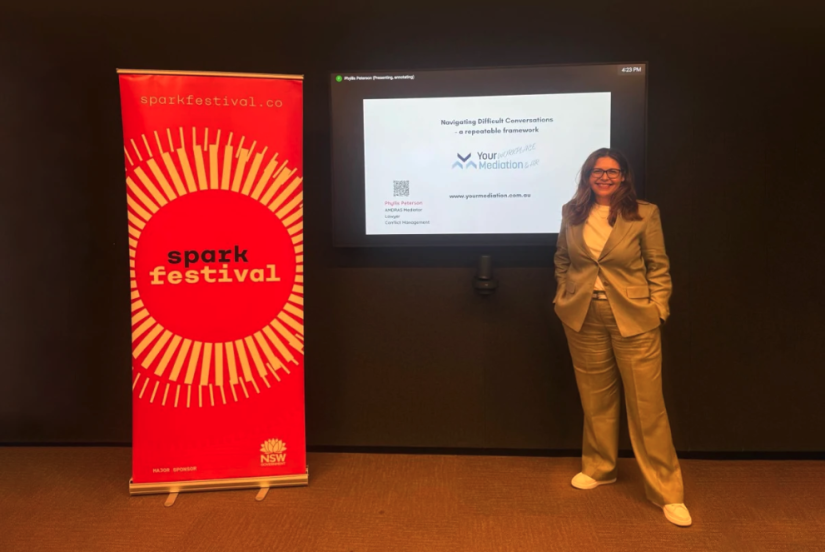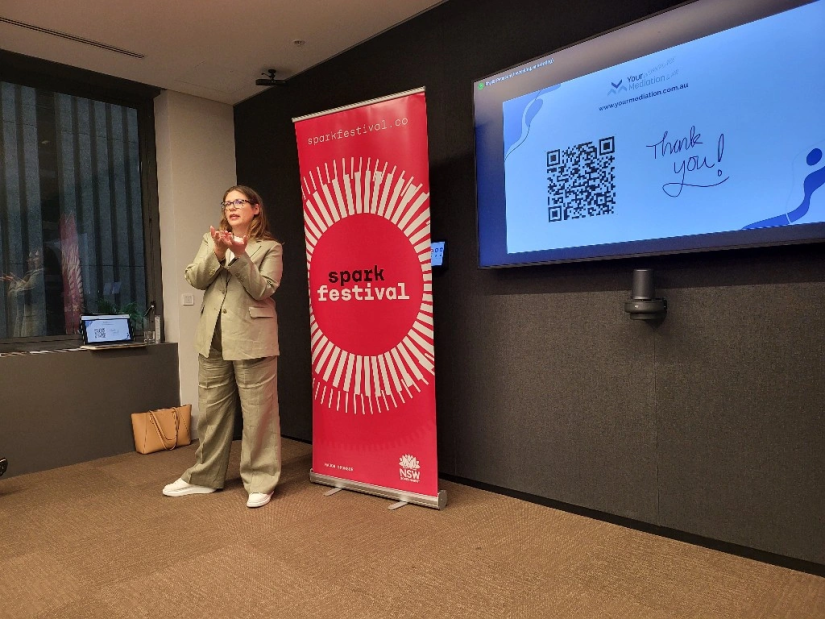Difficult conversations are part of life. So how can we navigate the journey from what’s going on to some kind of change? UTS Startups entrepreneur Phyllis Peterson established her business Your Mediation to help individuals navigate difficult conversations.
Navigating difficult conversations

Caption
Phyllis Peterson at Spark Festival
As part of the 2025 Spark Festival, Phyllis ran a workshop to guide people in how to approach and manage difficult conversations with confidence.
Qualified as a lawyer, mediator and coach, Phyllis introduced a repeatable and straight forward framework to help prepare us to move from disagreement to a state of acceptable change through a process of conflict resolution.
“Whether it’s giving feedback, preparing for a tricky negotiation or tackling a sensitive topic, the framework will help you maximise the opportunity to influence the change you seek,” she said.
Define the difficulty
Workshop participants were invited to bring a problem that would involve a difficult conversation
Phyllis asked us to first consider what it is about this conversation that is making it difficult. Sometimes it is hard to pinpoint exactly what the difficulty is.
“Keep it simple. One person, one problem. When there are many issues to consider, prepare an agenda. Although even when there are a myriad of issues to discuss, often you will find that there is one overarching issue that makes a number things difficult,” Phyllis said
Prepare for the conversation
When you prepare for a difficult conversation, you need to consider both the people involved as well as the issues at hand.
“We all have different communication styles and the way we handle conflict might be vastly different to the person we want to have a difficult conversation with,” Phyllis explained.
Whether it’s giving feedback, preparing for a tricky negotiation or tackling a sensitive topic, the framework will help you maximise the opportunity to influence the change you seek.
Is it clear to both you and the other party what exactly is the purpose of the conversation? And what the difficulty you want to discuss actually is?
“Be sure not to confuse the other party about why you are wanting to have a conversation,” she said. “You need to define its purpose before you meet and share that with them.”
If you do not make the topic of the conversation clear from the outset, you risk ambushing or confusing the other party and chance of a productive conversation can be lost.
Be aware that:
- different communication styles often make difficult conversations feel deeply personal
- personal triggers can make difficult conversations even harder as the amygdala shuts down and the fight or flight instinct kicks in
- values are important and may be challenged during a difficult conversation where misalignment may be triggering
- cultural issues may be relevant
- body language is important
- sometimes a ‘yes’ does not mean yes.
Be strategic
What do you want to happen as a result of this conversation? Phyllis recommends being clear about your desired result, and spending time mapping out different scenarios, from best to worst outcome.

“Before you have a difficult conversation, create a strategy comprising various outcomes, including those that may be achievable and those you may least want to occur,” Phyllis advised.
Among options you might consider preparing for are how you might be able to:
- ask questions to understand the other party’s thinking
- be prepared to test your assumptions
- understand what are the non-negotiables
- separate the people from the problem
- change the goalposts if you need to.
“Keep emotions out of it where possible. You need to draw a clear boundary so you can stick to the issues, “ Phyllis warned, adding that once someone is triggered, they are less likely to communicate effectively.
“When someone is flooded with emotion they will not be able to negotiate, so find a way to stop the conversation if you can see emotions are running too high.”
Execute the strategy
Phyllis reminded the workshop participants that it is not always about getting the best possible result. A compromise or change of plan can sometimes a good enough outcome. But how you get there should be clearly mapped out.
Ensure a clear time boundary so that each party is aware of what needs to be achieved within allocated timeframes. Prioritise listening and keeping calm.
“In execution, be sure to have a plan and stick to it,” Phyllis said. “Anchor the conversation early by setting out the purpose of the conversation.”
If parties will not stick to the agenda, bring them back to the purpose.
Anchor the conversation early by setting out the purpose of the conversation.
“Listen to understand. Be open and curious about what is the other party’s perspective,” Phyllis said. “Curious questions can reveal answers about the issues that may help you identify the next steps and pivot towards the outcomes you seek.”
Identify the next steps
To optimise any outcomes you have arrived at as a result of a difficult conversation, Phyllis said that it’s important that you and the other party agree on the next steps.
Close your conversation by discussing:
- what we are going to do now
- whether we need to continue the conversation.
About Your Mediation
As the founder of Your Mediation working out of UTS Startups, Phyllis is building technology to address workplace issues early and support psychosocial safety legal compliance. She says that the UTS Startup experience to date has been a game changer for her new venture.
“The support network, access to resources and expertise is more than I could have imagined.”
What’s next?
- To connect with Phyllis contact Your Mediation.
- Participate in Spark Festival.
- Learn more about UTS Startups.